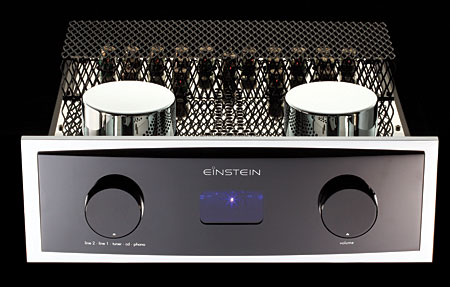“Since the advent of the CD, listeners have been deprived of the full experience of listening.” - Neil Young PonoPlayers...
Read More »
Einstein Audio The Tube Mk.II Preamplifier

Michael Fremer has posted a review of the Einstein Audio The Tube Mk.II preamplifier ($18,400) at Stereophile. His conclusions:
While the textural and harmonic aspects of the Einstein's sound could be dramatically changed by replacing its input tubes, The Tube Mk.II's overall performance was consistent in the ways that count most. The Tube Mk.II was among a handful of the quietest preamplifiers I've heard, tubed or solid-state. The backgrounds were velvet-black.
The Tube Mk.II was subjectively linear, with an ultrawide bandwidth, and perhaps a slight lower-midbass push that fleshed out standup bass, kick drums, timpani, and male voices—but so modestly that I could never identify it as an obvious coloration or noticeable thickness or congestion in that region.
Though the Einstein's top end sounded fully extended, some solid-state preamps might offer more air and resolution, which detractors of transistors would no doubt call brightness and/or clang. At the same time, The Tube Mk.II's top end was somewhat forward in the narrow band where cymbals and sibilants reside, particularly with its stock tubes—but it was never hard or harsh or grainy. That forwardness was there regardless of volume, but if the rest of your system sounds smooth, you'll probably become quickly addicted to it—or you can try some mellower tubes.
If, as I think it is, a preamp's job is to pass along the signal without adding to or subtracting from it anything at all, then Einstein's The Tube Mk.II comes as close to that ideal as any tube preamp I've heard—although, like every other audio component designed and built by mortals, it has a personality. If The Tube Mk.II adds anything, it's that bit of narrowband midbass emphasis, and perhaps the slightly forward but smooth and grain-free top-end, which I hesitate to call brightness. If it subtracts anything, it's some extension at the very bottom—something only a full-range speaker will reveal—and the last bit of macrodynamic explosiveness.
Those criticisms leveled, The Tube Mk.II's overall sound was so smooth, svelte, and even-handed that I never felt anything was missing. It wasn't dark or congealed, like some tube preamps, or overly pretty (except with the NOS Telefunken tubes), and the bottom end was anything but bloated, weak, or indistinct. So while The Tube Mk.II subtracted nothing critical from the sources feeding it that I could hear over a long audition period, it did add one thing I noticed: an extraordinarily high level of listening pleasure.
I enjoyed every listening session with The Tube Mk.II regardless of musical genre, though it was particularly effective reproducing classical music and jazz. I still prefer the darTZeel NHB-18NS, which costs about $10,000 more, but I'm sure many listeners will prefer having The Tube Mk.II (less "clang"), and leaving that 10 grand in the bank.
You can read the full review here.

